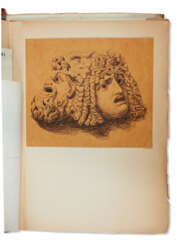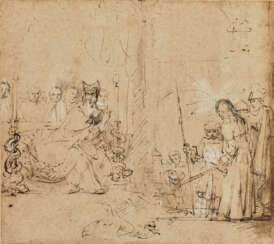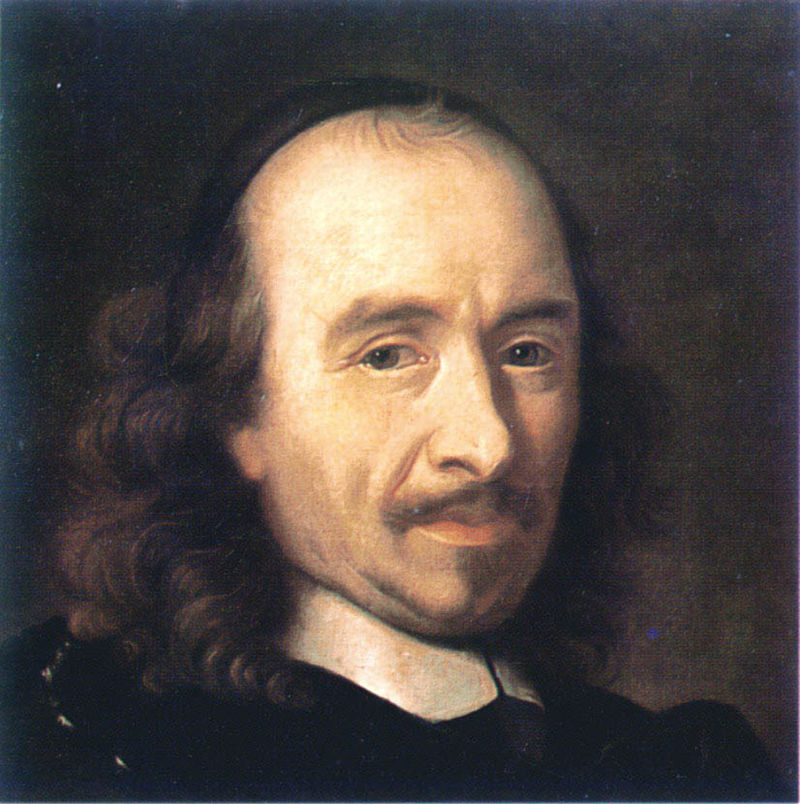théâtre de la ville



Jean-Louis André Théodore Géricault was a French painter and lithographer, celebrated for his pivotal role in the Romantic movement. Born in Rouen, France, in 1791, and educated among the elite in Paris, Géricault developed a profound connection with art from a young age, influenced by his training under notable figures like Carle Vernet and Pierre-Narcisse Guérin. This foundation set him on a path that diverged significantly from the classical traditions of his time.
Géricault's artistry is best known for its vibrant energy and emotional intensity, characteristics that marked a departure from the Neoclassical style predominant in the early 19th century. His most famous work, "The Raft of the Medusa" (1818–19), is a monumental canvas that dramatizes the tragic aftermath of the French shipwreck, Méduse, capturing the public and critical imagination for its raw portrayal of human despair and resilience. This painting not only criticized the French government but also showcased Géricault's masterful handling of drama, becoming an iconic symbol of Romanticism.
Throughout his career, Géricault remained deeply engaged with contemporary issues and the human condition, exploring themes of mental illness, social injustice, and the raw power of nature versus human vulnerability. His series of portraits depicting patients with mental illnesses, created towards the end of his life, highlighted his empathy and innovative approach to capturing human emotion and psychological depth.
Géricault's fascination with the dynamic forms and emotional potential of horses also led to some of the most stirring equestrian art of his time, reflecting his personal passion for horseback riding and his exceptional understanding of equine anatomy. This interest is evident in works like "A Horse Frightened by Lightning", showcasing his ability to capture motion and emotion in both human and animal forms.
Despite his premature death at the age of 32, Géricault's legacy endures, with his works residing in prestigious institutions like the Louvre in Paris. His artistic vision and dedication to portraying the realities and turbulences of his era have cemented his status as a pioneer of Romanticism, influencing subsequent generations of artists, including his contemporary and friend, Eugène Delacroix.
For collectors and experts in art and antiques, Géricault's oeuvre offers a profound insight into the Romantic spirit, embodying the tumult, passion, and innovation of an era on the cusp of modernity. His works continue to inspire and captivate audiences, reminding us of the power of art to provoke thought and evoke deep emotional responses.
To stay updated on exhibitions and auction events featuring Géricault's works, sign up for updates. This subscription will keep you informed on new discoveries and sales related to this influential artist, ensuring you never miss an opportunity to engage with the legacy of Jean-Louis André Théodore Géricault.




Jean-Louis André Théodore Géricault was a French painter and lithographer, celebrated for his pivotal role in the Romantic movement. Born in Rouen, France, in 1791, and educated among the elite in Paris, Géricault developed a profound connection with art from a young age, influenced by his training under notable figures like Carle Vernet and Pierre-Narcisse Guérin. This foundation set him on a path that diverged significantly from the classical traditions of his time.
Géricault's artistry is best known for its vibrant energy and emotional intensity, characteristics that marked a departure from the Neoclassical style predominant in the early 19th century. His most famous work, "The Raft of the Medusa" (1818–19), is a monumental canvas that dramatizes the tragic aftermath of the French shipwreck, Méduse, capturing the public and critical imagination for its raw portrayal of human despair and resilience. This painting not only criticized the French government but also showcased Géricault's masterful handling of drama, becoming an iconic symbol of Romanticism.
Throughout his career, Géricault remained deeply engaged with contemporary issues and the human condition, exploring themes of mental illness, social injustice, and the raw power of nature versus human vulnerability. His series of portraits depicting patients with mental illnesses, created towards the end of his life, highlighted his empathy and innovative approach to capturing human emotion and psychological depth.
Géricault's fascination with the dynamic forms and emotional potential of horses also led to some of the most stirring equestrian art of his time, reflecting his personal passion for horseback riding and his exceptional understanding of equine anatomy. This interest is evident in works like "A Horse Frightened by Lightning", showcasing his ability to capture motion and emotion in both human and animal forms.
Despite his premature death at the age of 32, Géricault's legacy endures, with his works residing in prestigious institutions like the Louvre in Paris. His artistic vision and dedication to portraying the realities and turbulences of his era have cemented his status as a pioneer of Romanticism, influencing subsequent generations of artists, including his contemporary and friend, Eugène Delacroix.
For collectors and experts in art and antiques, Géricault's oeuvre offers a profound insight into the Romantic spirit, embodying the tumult, passion, and innovation of an era on the cusp of modernity. His works continue to inspire and captivate audiences, reminding us of the power of art to provoke thought and evoke deep emotional responses.
To stay updated on exhibitions and auction events featuring Géricault's works, sign up for updates. This subscription will keep you informed on new discoveries and sales related to this influential artist, ensuring you never miss an opportunity to engage with the legacy of Jean-Louis André Théodore Géricault.


Charles Leconte de Lisle, full name Charles Marie René Leconte de Lisle, was a French poet and politician, head of the Parnassus poetic movement.
He was a member of the Revolution of 1848 and initiator of the law on the abolition of slavery in the colonies. As a poet, he was highly regarded by his contemporaries, including Victor Hugo. Leconte de Lisle's poems are characterized by a clear, sculptural, "objective" form. He translated into French a number of classical Greek works.




Willem Drost was a notable Dutch Golden Age painter and printmaker known for his history paintings and portraits. His journey through the art world led him from his birthplace in Amsterdam to the vibrant cultural scene of Venice, where he spent his final years. Drost's work, particularly influenced by his time as one of Rembrandt's most gifted pupils, showcases a mastery of Baroque style, characterized by dramatic use of light and shadow, and a focus on realism and emotional depth.
Despite the relatively small number of works directly attributed to Drost, his legacy is significant, with several of his paintings having been mistakenly attributed to Rembrandt for centuries. This confusion underscores Drost's skill in emulating Rembrandt's style so closely that discerning between the master's and the pupil's work became a subject of scholarly investigation. Among Drost's known pieces, "Bathsheba" (1654), held at the Louvre, stands out for its sensuous portrayal of the biblical figure, showcasing Drost's ability to capture the nuanced interplay of light and shadow, as well as the psychological complexity of his subjects.
Drost's contribution to the Dutch Golden Age of painting is now more clearly recognized, with artworks such as "The Polish Rider," once thought to be by Rembrandt, suggested by some scholars as possibly being his work. While controversial, this reevaluation of Drost's contributions highlights the ongoing discussion about attribution within the art community and the importance of pupils in the studios of great masters like Rembrandt.
For collectors and experts in art and antiques, Willem Drost offers a fascinating glimpse into the world of the Dutch Golden Age, where the lines between master and pupil blur in the shared pursuit of artistic excellence. His works, housed in museums like the Ashmolean Museum in Oxford, the Metropolitan Museum of Art in New York City, and The Wallace Collection in London, continue to captivate audiences with their beauty and emotional depth.
To stay informed about new discoveries, sales, and auction events related to Willem Drost, signing up for updates from art galleries and auction houses is recommended. This ensures access to the latest information and opportunities to engage with the works of this remarkable artist who played a vital role in the legacy of the Dutch Golden Age.



Leon Bakst (Russian: Лев Самойлович Бакст) was a prominent Russian painter and stage designer, celebrated for his innovative contributions to the world of art and theater. Born in the late 19th century, Bakst became a central figure in the cultural renaissance that swept through Russia and Europe, leaving an indelible mark on the visual and performing arts.
Bakst's work is distinguished by its rich use of color, intricate patterns, and imaginative compositions, which brought to life the exotic and often fantastical themes of the ballets and operas for which he designed. His association with the Ballets Russes, a groundbreaking ballet company that performed across Europe and America, solidified his reputation as a visionary artist. The costumes and sets he created for productions like "The Firebird" and "Scheherazade" were celebrated for their creativity and exoticism, influencing not only the world of theater but also fashion and interior design.
His art extends beyond the stage, with paintings and illustrations that capture the same vibrancy and innovation found in his theatrical work. Museums and galleries around the world, including the State Russian Museum in St. Petersburg and the Metropolitan Museum of Art in New York, house his works, allowing art lovers to experience the magic of Bakst's creations.
For collectors and experts in art and antiques, Leon Bakst's work offers a unique glimpse into a transformative period of cultural history, where the boundaries of art and performance were reimagined. His legacy continues to inspire and captivate, making his pieces highly sought after in the art world.
We invite enthusiasts and collectors to sign up for updates on new product sales and auction events related to Leon Bakst. This subscription ensures you remain informed about opportunities to acquire pieces connected to this extraordinary artist's legacy, without any overbearing commitments. Join us in celebrating the enduring impact of Leon Bakst's art and design.


Léon Spilliaert was a Belgian artist. He is known for his unique style of symbolism, with many of his works featuring dream-like landscapes, eerie still lifes, and enigmatic figures.
Spilliaert grew up in a wealthy family, and he initially studied architecture before turning to art. He was largely self-taught, and his work was heavily influenced by the Belgian symbolist movement, as well as the works of artists such as James Ensor and Edvard Munch.
Spilliaert was particularly interested in exploring the mysteries of the human psyche, and many of his works reflect a sense of unease or uncertainty. He often used strong contrasts of light and shadow to create a sense of drama and tension in his works, and his use of color was often muted and subdued.
Despite his success as an artist, Spilliaert was a deeply private individual, and he rarely exhibited his work during his lifetime. He continued to work throughout his life, however, producing a large body of haunting and enigmatic works that continue to captivate audiences today.






![DU BELLAY, Joachim (1522-1560). La deffence, et illustration de la Langue Francoyse. Par I. D. B. A. [relié avec] L’Olive et quelques autres œuvres poetiques. Le contenu de ce livre. Cinquante Sonnetz à la louange de l’Olive. L’Anterotique de la](/assets/image/picture_1320811/66de9/12c376053e80b5b47114c4b2b18070da1616454000jpg__fix_374_244.jpeg)
![DU BELLAY, Joachim (1522-1560). La deffence, et illustration de la Langue Francoyse. Par I. D. B. A. [relié avec] L’Olive et quelques autres œuvres poetiques. Le contenu de ce livre. Cinquante Sonnetz à la louange de l’Olive. L’Anterotique de la](https://veryimportantlot.com/assets/image/picture_1320811/66de9/12c376053e80b5b47114c4b2b18070da1616454000jpg__fix_374_244.jpeg)



































































